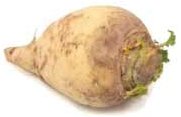Rutabaga

It ia Large yellow root of a rutabaga plant used as food, a cruciferous plant with a thick bulbous edible yellow root.
Rutabaga[edit]



Rutabaga is a root vegetable that is similar to turnips but has a slightly sweeter and milder flavor. It is a good source of dietary fiber, vitamin C, and potassium, and can be a healthy addition to a balanced diet.
Preparation and Culinary Uses[edit]
Rutabaga can be prepared in a variety of ways, such as:
- Roasting
- Boiling
- Mashing
It is often used in stews and soups, and can also be sliced and eaten raw in salads. Rutabaga is often used in hearty stews and casseroles, and can also be mashed and used as a substitute for potatoes in dishes such as shepherd's pie.
Health Benefits and Medicinal Uses[edit]
In addition to its culinary uses, rutabaga has a long history of medicinal use in many cultures. It is believed to have anti-inflammatory properties and is often used to treat respiratory issues and digestive problems.
Purchasing and Storage[edit]
Rutabaga can be found in most grocery stores and specialty markets, either fresh or canned. When purchasing fresh rutabaga, it is important to choose roots that are firm and free from blemishes or soft spots.
Interesting facts about rutabagas[edit]

- Rutabagas are also known as "Swede" or "yellow turnips".
- Rutabagas look similar to turnips, as they are both root vegetables.
- The part of the rutabaga that we eat is the root, which grows underground.
- Rutabagas are a hybrid of cabbage and turnip.
- The name "rutabaga" comes from the Swedish word "rotabagge", which means round root.
- Rutabagas have a violet top and a yellow-tan bottom.
- To protect themselves from losing moisture and shriveling up, rutabagas have a wax coating.
- The flesh of rutabagas is pale yellow or tan in color.
- When cooked, rutabagas turn orange.
- A ½ cup of cooked rutabaga contains 25% of the recommended daily value for vitamin C, which helps the body form collagen in bones, cartilage, muscle, and blood vessels, and aids in the absorption of iron.
- Cooked rutabagas only contain 35 calories per ½ cup.
- Rutabagas are typically larger and sweeter than turnips.
- Rutabagas can be cooked like potatoes, and mashed rutabagas are delicious.
- Cooked rutabagas have a potato-like texture.
- Rutabagas are typically grown in cooler climates.
- If stored in a cool, dark place, rutabagas can keep for over a month.
Summary[edit]
Overall, rutabaga is a nutritious and versatile root vegetable that can be used in a wide variety of dishes and has a long history of use in both culinary and medicinal traditions.
References[edit]
| This article is a stub. You can help WikiMD by registering to expand it. |
Ad. Transform your life with W8MD's Budget GLP-1 injections from $75


W8MD offers a medical weight loss program to lose weight in Philadelphia. Our physician-supervised medical weight loss provides:
- Weight loss injections in NYC (generic and brand names):
- Zepbound / Mounjaro, Wegovy / Ozempic, Saxenda
- Most insurances accepted or discounted self-pay rates. We will obtain insurance prior authorizations if needed.
- Generic GLP1 weight loss injections from $75 for the starting dose.
- Also offer prescription weight loss medications including Phentermine, Qsymia, Diethylpropion, Contrave etc.
NYC weight loss doctor appointmentsNYC weight loss doctor appointments
Start your NYC weight loss journey today at our NYC medical weight loss and Philadelphia medical weight loss clinics.
- Call 718-946-5500 to lose weight in NYC or for medical weight loss in Philadelphia 215-676-2334.
- Tags:NYC medical weight loss, Philadelphia lose weight Zepbound NYC, Budget GLP1 weight loss injections, Wegovy Philadelphia, Wegovy NYC, Philadelphia medical weight loss, Brookly weight loss and Wegovy NYC
|
WikiMD's Wellness Encyclopedia |
| Let Food Be Thy Medicine Medicine Thy Food - Hippocrates |
Medical Disclaimer: WikiMD is not a substitute for professional medical advice. The information on WikiMD is provided as an information resource only, may be incorrect, outdated or misleading, and is not to be used or relied on for any diagnostic or treatment purposes. Please consult your health care provider before making any healthcare decisions or for guidance about a specific medical condition. WikiMD expressly disclaims responsibility, and shall have no liability, for any damages, loss, injury, or liability whatsoever suffered as a result of your reliance on the information contained in this site. By visiting this site you agree to the foregoing terms and conditions, which may from time to time be changed or supplemented by WikiMD. If you do not agree to the foregoing terms and conditions, you should not enter or use this site. See full disclaimer.
Credits:Most images are courtesy of Wikimedia commons, and templates, categories Wikipedia, licensed under CC BY SA or similar.
Translate this page: - East Asian
中文,
日本,
한국어,
South Asian
हिन्दी,
தமிழ்,
తెలుగు,
Urdu,
ಕನ್ನಡ,
Southeast Asian
Indonesian,
Vietnamese,
Thai,
မြန်မာဘာသာ,
বাংলা
European
español,
Deutsch,
français,
Greek,
português do Brasil,
polski,
română,
русский,
Nederlands,
norsk,
svenska,
suomi,
Italian
Middle Eastern & African
عربى,
Turkish,
Persian,
Hebrew,
Afrikaans,
isiZulu,
Kiswahili,
Other
Bulgarian,
Hungarian,
Czech,
Swedish,
മലയാളം,
मराठी,
ਪੰਜਾਬੀ,
ગુજરાતી,
Portuguese,
Ukrainian